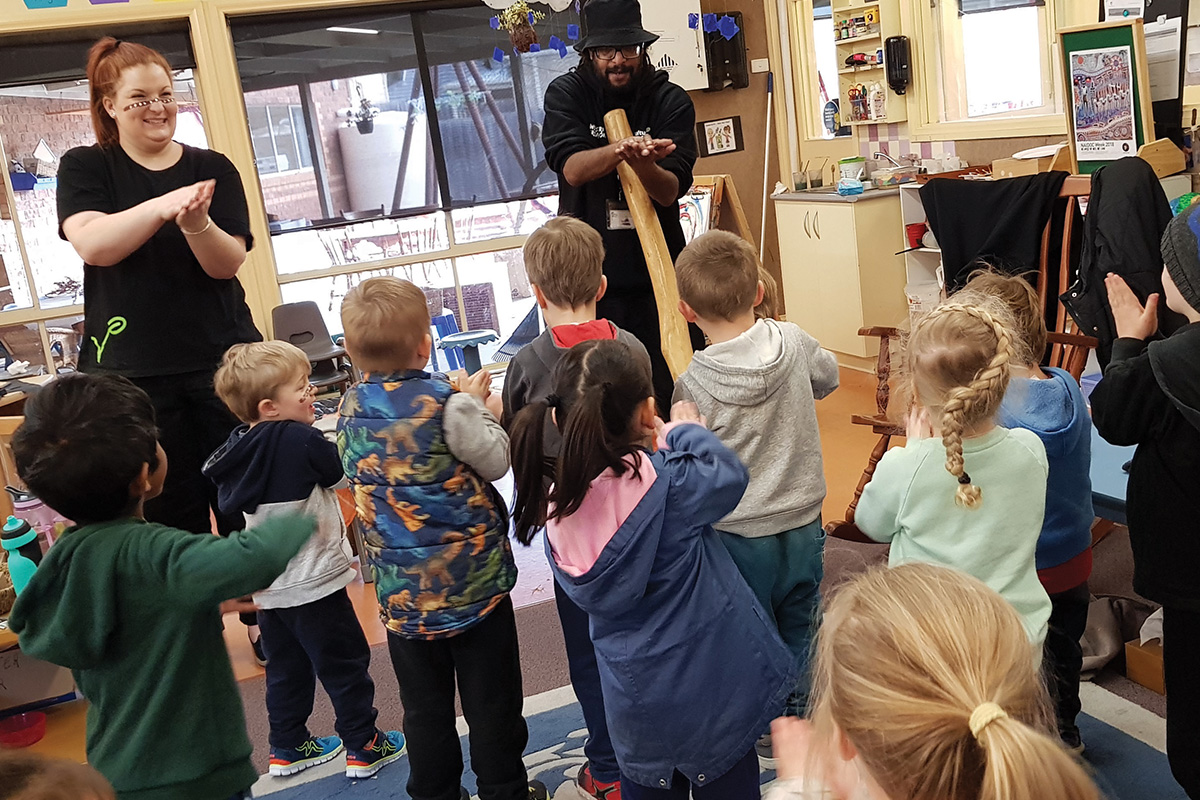
Music, in all its forms, is the most ancient of arts within all cultures. Whenever communities gather for special events, rituals, and spiritual observations, music is at the core. Australian Aborigines have had a continuous culture of over 50,000 years. Whether singing, clap sticks, didgeridoo, gum leaf, or bullroarer, indigenous music has developed in unique ways throughout the continent. Migration and trade-in pre- and post- white settlement created interchange of particular styles and applications.
Around the world, the first instrument people think of when the term ‘Australian Aboriginal music’ is mentioned is the didgeridoo. Although traditionally the didgeridoo was not widespread around the country – it was an instrument belonging to the Aboriginal groups in the most northerly areas (Arnhem Land in particular) – today it is commonly considered the national instrument of the Australian Aborigines and played by southern peoples equally. The didgeridoo is now world-renowned as the unique and iconic instrument of Australia’s First People.
Students can now create and replicate the sounds of these iconic instruments – gum leaf, didgeridoo, clap sticks, to name a few – into their own compositions without physically having the instruments at hand, let alone learning how to play them. Students can make canvases of sounds for their own unique compositions through the Sound Infusion app created by Cultural Infusion of which there are 500+ loops of Australian music. This is not only an app for music teachers to have as a teaching tool, but for any teacher to use, as there is no musical ability needed to apply it. It is all done by ear and sound exploration. Students can also mix the sounds of different cultures together. The possibilities are endless.
The Sound Infusion app is an excellent tool to apply in the classroom, addressing the curriculum priorities of ACARA in Intercultural Understanding through the Music stream.
To quote directly from the ACARA site:
“The Australian Curriculum sets consistent national standards to improve learning outcomes for all young Australians. ACARA acknowledges the gap in learning outcomes between Aboriginal and Torres Strait Islander students and their non-Indigenous peers. It recognises the need for the Australian Curriculum to provide every opportunity possible to ‘close the gap’.
Therefore, the Australian Curriculum is working towards addressing two distinct needs in Aboriginal and Torres Strait Islander education:
- Aboriginal and Torres Strait Islander students are able to see themselves, their identities and their cultures reflected in the curriculum of each of the learning areas can fully participate in the curriculum and can build their self-esteem
- The Aboriginal and Torres Strait Islander Histories and Cultures cross-curriculum priority are designed for all students to engage in reconciliation, respect and recognition of the world’s oldest continuous living cultures.

In understanding how these ancient groups of traditional peoples lived and interacted with the environment and spirit worlds through music provides us with ways to improve contemporary living. The wisdom of Elders, when respected and valued, has made and still is making, a valuable contribution to enhancing our contemporary shared diversities, understand the need for sustainability, and respecting the environment and the symbolic power it can have over people who have maintained and inhabited this land for millennia. Indigenous music is a direct expression of all these cultural aspects of life and living for Australia’s first people.
In fact, through Learning Lands platform of apps, the ACARA Cross-Curriculum priority of ‘Aboriginal and Torres Strait Islander Histories and Cultures’ can be addressed through Mungo Explorer, and directly through the interactive learning of the incursion experience: Indigenous Infusion, Kinder Dreaming, Artist in Residence – Indigenous Mural Art, and Aboriginal Culture for a Day. These incursion programs are available in almost all states of Australia. (Contact Cultural Infusion on 1800 010 069 to book or discuss your curriculum needs and find out more about this and other programs we can offer your school or event.)
But to truly integrate cultural learning, music is the key. Music, as the universal language, transmits a given culture beyond the use of language. The music conjures up landscapes and weather, desert and forest, river and ocean, spirits and demons.

Sound Infusion can achieve this with minimal teacher oversight. Within the platform is an extensive set of complete lesson plans that can be adjusted to a given year level (Year 4 to 10) and interrelates music with other cultural phenomena, such as feasts, festivities, community celebrations and emotional expression of landscape and spirit. Your students will come to grasp indigenous culture far beyond the textbook, but as a hands-on experience.
Please explore the links in this blog and, if you are unsure how to approach teaching indigenous studies and applying these various teaching tools, please ring 1800 010 069 and speak to either one of our curriculum advisors or they can put you in touch with an Aboriginal Elder who has worked in within schools for some 30 years. Al will more than pleased to assist you in this as teaching Aboriginal culture is his lifelong passion.
Share this Post



